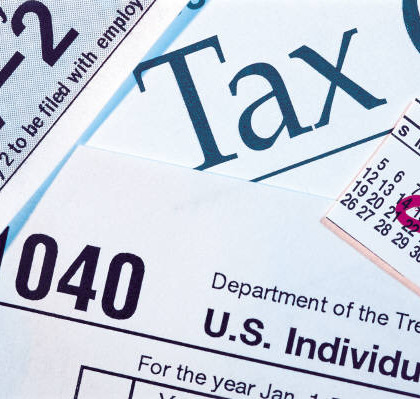Top 10 year-end tax planning tips
Another year is coming to a close, which only means a season of taxes is slowly approaching. Tax time can often be one of the most stressful times of the year for businesses, employees, and even clients, but that just means helping clients with a less stressful year-end planning session more crucial than ever. Read this blog post for helpful tips.
Between the upcoming presidential election and the COVID-19 pandemic and its attendant stimulus packages, this year has seen more than its share of uncertainty around tax — which makes helping clients with year-end planning all the more crucial.
“Year-end tax planning is more important than ever this year,” said Renato Zanichelli, national managing partner of tax services at Grant Thornton, in a statement. “Businesses both large and small have been dealt a tough hand. Having the right tax strategy will help businesses navigate this time of historic disruption and put them on the right track as a new year begins.”
“Lawmakers dedicated trillions of dollars to keep families and businesses afloat, but those provisions may also require quick action, in many cases by the end of this year,” added Dustin Stamper, managing director in the firm’s Washington National Tax Office. “The government wants to get money in the hands of those who need it, and many of the most generous provisions are tax changes that provide welcome liquidity for businesses and timely relief for individuals.”
With that in mind, the Top Eight Firm has put together a list of 10 key tax considerations for year-end planning for both individuals and businesses (below); for more see their year-end tax planning guides.
Accounting method changes are among the most powerful ways to accelerate deductions, but remember any non-automatic changes a company wants to make effective for the 2020 calendar year must be made by the end of the year. C corporations make NOL refund claims themselves, but passthrough businesses like partnerships and S corporations pass losses onto to owners, who will make claims.
The fastest way to obtain a refund is generally by filing a tentative refund claim, but these must be filed by Dec. 31, 2020, for the 2019 calendar year. If losses will be in 2020, the business should start preparing to file early, because they cannot claim an NOL carryback refund until they file their tax return for the year.
Tax rules allow businesses to claim certain losses attributable to a disaster on a prior-year tax return. This is meant to provide quicker refunds. President Donald Trump’s COVID-19 disaster declaration was unprecedented in scope, designating all 50 states, the District of Columbia and five territories as disaster areas. This means essentially every U.S. business is in the covered disaster area and may be eligible for refunds from certain types of losses. Under this provision, a business could claim a COVID-19 related disaster loss occurring in 2020 on a 2019 amended return for a quicker refund. The provision may potentially affect losses arising in a variety of circumstances, including the loss of inventory or supplies or the closure of offices, stores or plants. To qualify, the loss must actually be attributable to or caused by COVID-19 and satisfy several other requirements.
Older workers are staying in the job market. Here’s why
According to the Bureau of Labor Statistics, the amount of employees over the age of 65 has risen by 697,000. With over two million jobs being created over the past 12 months with the help of the economy, the older generations are still wanting to be employed. Read this blog post to learn more as to why.
Older workers are sticking around the job market. This is why
The number of workers aged 65 and above increased by 697,000 as the economy created more than 2 million new jobs over the past 12 months, according to data from the Bureau of Labor Statistics in this CNBC article. The spike in the number of older workers represents about 36% of the overall increase, reflecting a trend over the past 10 years. “The norms about working at older ages have changed quite a bit, and I think in a way that really is to the advantage of older workers who want to keep working,” says an expert.
What ‘Rothifying’ 401(k)s would mean for retirees
Clients will not benefit from a switch to a retirement system where contributions would be made on an after-tax basis even if it could result in bigger tax revenue in the near term, experts write in The Wall Street Journal. "Over their lifetimes, workers would accumulate one-third less in their 401(k)s under a Roth system. This is because, with no tax advantage from contributing to a 401(k), workers would save less and those lower contributions would earn less over the years," they write. Moreover, "lifetime tax revenue generated by the average worker under a Roth regime would fall 6% to 10%, compared with the current regime."
Stop 'dollar-cost ravaging' your clients’ portfolio in retirement
Retirees who stick to a 4% withdrawal rule during a market downturn are putting their financial security at risk, as their portfolio would not recover even if the market eventually improves, writes an expert in Kiplinger. Instead, seniors should focus on how much income they can generate from their portfolio, he writes. "[I]t means choosing investments — high dividend-paying stocks, fixed income instruments, annuities, etc. — that will produce the dollar amount you need ($2,000, $3,000, $5,000 or more) month after month and year after year."
Will clients owe state taxes on their Social Security?
Retirees may face federal taxation on a portion of their Social Security benefits — but they could avoid the tax bite at the state level, as 37 states impose no taxes on them, writes a Forbes contributor. "While probably not a big enough issue to warrant moving in retirement, it is something to consider when choosing where you want to spend your retirement," writes the expert. "At the very least, you need to know about Social Security taxation when figuring out how much additional income you will need to have in order to maintain your standard of living during retirement."
8 ways clients can start saving for college now
There are a few savings vehicles that clients can use to prepare for college expenses, but they need to consider the pros and cons, according to this article in Bankrate. For example, clients who save in a 529 savings plan can get tax benefits — such as tax deferral on investment gains and tax-free withdrawal for qualified expenses — but will face penalties for unqualified withdrawals aside from taxes. Parents may also use a Roth IRA to save for their child's college expenses, but these accounts are subject to contribution limits and future distributions will be treated as an income, which can reduce their child's eligibility for scholarships or assistance.
SOURCE: Peralta, P. (18 February 2020) "Older workers are staying in the job market. Here’s why" (Web Blog Post). Retrieved from https://www.employeebenefitadviser.com/news/why-older-workers-are-staying-in-the-job-market
The Mega Backdoor Roth IRA and Other Ways to Maximize a 401(k)
Did you know: Numerous 401(k) retirement plans allow after-tax contributions. This creates financial planning opportunities that are frequently overlooked. Read this blog post for more information on maximizing your 401(k) plan.
The most popular workplace-sponsored retirement plan is far and away the 401(k) — a plan that can be both simple and complex at the same time. For some of your clients, it functions as a tax-deductible way to save for retirement. Others might see its intricacies as a way to maximize lifetime wealth, boost investments and minimize taxes. One such niche area of 401(k) planning is after-tax contributions, an often misunderstood and underutilized area of planning.
Before we jump into after-tax contributions, we need to cover the limits and the multiple ways your clients can invest money into 401(k) plans.
Employee Salary Deferrals and Roth
The most traditional way you can contribute money to a 401(k) is by tax-deductible salary deferrals. In 2019, employees can defer up to $19,000 a year. If they’re age 50 or older, they can contribute an additional $6,000 into the plan. In 2020, these numbers for “catch-up contributions” rise to $19,500 and $6,500 respectively.
Someone age 50 or over can put up to $25,000 into a 401(k) in 2019 and $26,000 in 2020 through tax-deductible salary deferrals. Additionally, the salary deferral limits could instead be used as a Roth contribution, but with the same limits. The biggest difference is that Roth contributions are after-tax. And as long as certain requirements are met, the distributions, including investment gains, come out income tax-free, whereas tax-deferred money is taxable upon distribution.
Employer Contributions
Employers often make contributions to a 401(k), with many matching contributions. For instance, if an employee contributes 6% of their salary (up to an annual indexed limit on salary of $280,000 in 2019 and $285,000 in 2020), the company might match 50%, 75%, or 100% of the amount. For example, if an employee earns $100,000 a year and puts in $6,000 and their employer matches 100%, they will also put in $6,000, and the employee will end up with $12,000 in their 401(k). Employers can also make non-elective and profit-sharing contributions.
Annual 401(k) Contribution Cap
Regardless of how money goes into the plan, any individual account has an annual cap that includes combined employee and employer contributions. For 2019, this limit is $56,000 (or $62,000 if the $6,000 catch-up contribution is used for those age 50 and over). For 2020, this limit rises to $57,000 ($63,500 if the $6,500 catch-up contribution is used for those age 50 and over).
Inability to Max Out Accounts
If you look at the limits and how people can contribute, you might quickly realize how hard it is to max out a 401(k). If a client takes the maximum salary deferral of $19,000 and an employer matches 100% (which is rare), your client would only contribute $38,000 into the 401(k) out of the maximum of $56,000. Their employer would need to contribute more money in order to max out.
Where After-Tax Contributions Fit In
Not all plans allow employees to make after-tax contributions. If the 401(k) did allow this type of contribution, someone could add more money to the plan in the previous example that otherwise maxed out at $38,000.
After-tax contributions don’t count against the salary deferral limit of $19,000, but they do count toward the annual cap of $56,000. After-tax contributions are what they sound like — it’s money that’s included into the taxable income after taxes are paid, so the money receives all the other benefits of the 401(k) like tax-deferred investment gains and creditor protections.
With after-tax contributions, clients can put their $19,000 salary deferral into the 401(k), get the $19,000 employer match, and then fill in the $18,000 gap to max out the account at $56,000.
Mega-Roth Opportunity
If the plan allows for in-service distributions of after-tax contributions and tracks after-tax contributions and investment gains in separate accounts from salary deferral and Roth money, there’s an opportunity to do annual planning for Roth IRAs.
Clients can convert after-tax contributions from a 401(k) plan into a Roth IRA, without having to pay additional taxes. If a plan allows in-service distributions of after-tax contributions, the money can be rolled over to a Roth IRA each year. However, it’s important to note that any investment gains on the after-tax amount would still be distributed pro rata and considered taxable. Earnings on after-tax money only receive tax-deferred treatment in a 401(k); they aren’t tax free.
Clients can roll over tens of thousands of dollars a year from a 401(k) to a Roth IRA if the plan is properly set up. They can even set up a plan in such a way so the entire $56,000 limit is after-tax money that’s distributed to a Roth IRA each year with minimal tax implications. This strategy is referred to as the Mega Backdoor Roth strategy.
Complexities Upon Distribution of After-Tax Contributions
What happens to after-tax contributions in a 401(k) upon distribution? This is a complex area where you can help clients understand the role of two factors:
- After-tax contributions are distributed pro-rata (proportional) between tax-deferred gain and the after-tax amounts.
- Pre-tax money is usually considered for rollover into a new 401(k) or IRA first, leaving the after-tax attributed second. The IRS provided guidance on allocation of after-tax amounts to rollovers in Notice 2014-54.
Best Practices for Rollovers
Help your clients navigate the world of rollovers with after-tax contributions by following best practices. If a client does a full distribution from a 401(k) at retirement or separation of service, they can roll the entire pre-tax amount to a new 401(k) or IRA and separate out the after-tax contributions to roll over into a Roth IRA. The IRS Notice 2014-54 previously mentioned also provides guidance for this scenario.
You can help your clients understand after-tax contributions by envisioning after-tax money in a 401(k) as the best of three worlds. These contributions enter after taxes and give your client tax-deferred money on investment growth, allow them to save more money in their 401(k) while also giving them the opportunity to roll it over into a Roth IRA at a later date.
After-tax contributions build numerous planning options and tax diversification into retirement plans. Before your clients allocate money toward after-tax contributions, it’s important they understand what their plan allows and how it fits into their overall retirement and financial planning picture.
SOURCE: Hopkins, J. (17 December 2019) "The Mega Backdoor Roth IRA and Other Ways to Maximize a 401(k)" (Web Blog Post). Retrieved from https://www.thinkadvisor.com/2019/12/17/the-mega-backdoor-roth-ira-and-other-ways-to-maximize-a-401k/
7 ways to reduce stress this tax season
Does tax season leave you stressed out? Tax season is here, leaving many employers face-to-face with a number of demands. Continue reading this post from Employee Benefit News for seven ways employers can reduce stress during tax season.
Tax filing season is here, which means many employers will come face-to-face with a number of demands. Whether they do their own taxes, use online tax software or meet with a trusted tax adviser, there are many useful resources out there that will help employers work smarter, not harder.
Here are seven ways employers can reduce stress during tax season.
2019 U.S. Master Tax Guide
The U.S. Master Tax Guide contains timely and precise explanations of federal income taxes for individuals, partnerships and businesses. This guide contains information including tax tables, tax rates, checklists, special tax tables and explanatory text.
Legislative resources
Find a trusted, reputable resource for the latest news, opinions and laws regarding healthcare. Many companies in the industry have a designated section on their website that is dedicated to providing employers with updates and trends in the health insurance industry and how it will affect taxes.
Content Continues Below
Payroll calculators
Employers can use payroll calculators to determine gross pay, withholdings, deductions, net pay after Social Security and Medicare and more. Calculator types include salary payroll calculators, hourly paycheck calculators, gross pay calculators, W-4 assistants, percentage bonus calculators and aggregate bonus calculators.
Keep, shred, toss
Now is the perfect time to organize tax records so that they’re easy to find in case they’re needed to apply for a loan, answer IRS questions or file an amended return.
The IRS has some helpful guidance you can share with your clients on what records to keep and for how long. They should remember to:
- Keep copies of tax returns and supporting documents for at least three years.
- Keep some documents for up to seven years.
- Keep healthcare information statements for at least three years. These include records of employer-provided coverage, premiums paid, advance payments of the premium tax credit received and type of coverage.
Make sure records are kept safe — but when it’s time, shred or destroy
Whether they consist of paper stacked in a shoebox, electronic files stored on a device or in the cloud, it’s important to safeguard all personal records, especially anything that lists Social Security numbers. Consumer Affairs recommends scanning paper and keeping records stored securely on a flash drive, CD or DVD.
It’s more important than ever for employers to keep personal information out of the hands of identity thieves. That means not tossing records in the trash or recycling bin. Home paper shredders are often inadequate for large piles of paper, but many communities have professional, secure document shredding services.
Content Continues Below
Start as early as possible
A deadline looming always makes the situation more stressful. It’s very important for employers to not wait until the last minute to start their tax return. If they choose to use a tax professional, be sure that they get in early. Tax professionals take on many clients, and only have a short timeframe to get all the work done.
Be honest
It may be tempting for employers to tell a white lie on their taxes to maximize their tax breaks or return, but that comes at a great risk. If they are audited by the IRS, they will liable for whatever was reported.
SOURCE: Waletzki, T. (12 March 2019) "7 ways to reduce stress this tax season" (Web Blog Post). Retrieved from https://www.benefitnews.com/list/how-to-reduce-stress-this-tax-season?brief=00000152-14a5-d1cc-a5fa-7cff48fe0001




